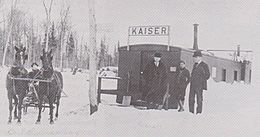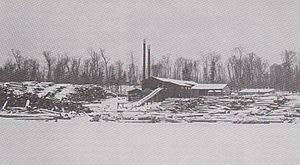Kaiser, Wisconsin facts for kids
Quick facts for kids
Kaiser, Wisconsin
|
|
|---|---|
|
Ghost town
|
|

The Kaiser Train Depot was a decommissioned boxcar.
|
|
| Country | United States |
| State | Wisconsin |
| County | Price |
| Elevation | 1,499 ft (457 m) |
| GNIS feature ID | 1833517 |
Kaiser is a ghost town in Price County, Wisconsin, USA. A ghost town is a place where people used to live and work, but now it's mostly empty. Kaiser was located near a path called the Tuscobia State Trail. It was about 5 miles (8 km) southwest of Park Falls. Maps showed Kaiser until about 1941.
Contents
The Story of Kaiser
The village of Kaiser was planned and named after Arnold E. Kaiser in 1911. He was a logger and an important person in nearby Park Falls.
Early Settlers and Farms
People started settling on farmland near Kaiser as early as 1881. John Stehwein was one of the first. He claimed 160 acres of land along County Road E. This area became known as "Kaiser's Corner."
Another early settler was C.M. Gardner. A nearby lake, Gardner Lake, was named after him.
Growing the Community
In October 1901, Walter Loomer built a small country store. A post office and a one-room school were already open when the village was planned.
The land around Kaiser was good for farming. It was mostly flat and had rich soil with few rocks. This brought many settlers who wanted to farm. By 1920, Kaiser had some of the best dairy farms in northern Price County.
The Sawmill and the Railroad
A sawmill was built in 1905 by J.S. Blackwell. It was located near a pond about half a mile west of "Kaiser's Corner." The sawmill gave many people jobs.
Blackwell hired J.W. and E.W. Noble to build and run the mill. Farmers brought logs to the mill. The lumber was then sold or shipped to Park Falls using horse-drawn wagons.
The sawmill's operations grew a lot in 1910. This happened when the Omaha Railway Line built a special track, called a siding, to the mill.
Big Plans and a Quiet End
Arnold Kaiser, who was a logger, bought out the Nobles and ran the mill with Blackwell. He planned his new village where the sawmill's track met the main Omaha Railway line.
Mr. Kaiser hoped to sell land in the village for homes and businesses. He dreamed of a busy community named after himself. For three years, the Kaiser village was the end of the Omaha Railway Line. But only one house was ever built in his planned village. It was later called "The Chicken House."
The real Kaiser community grew around the sawmill and "Kaiser's Corner." This is where homes, the post office, school, and general store were built. Mr. Kaiser's big plans for a large, busy town never came true.



